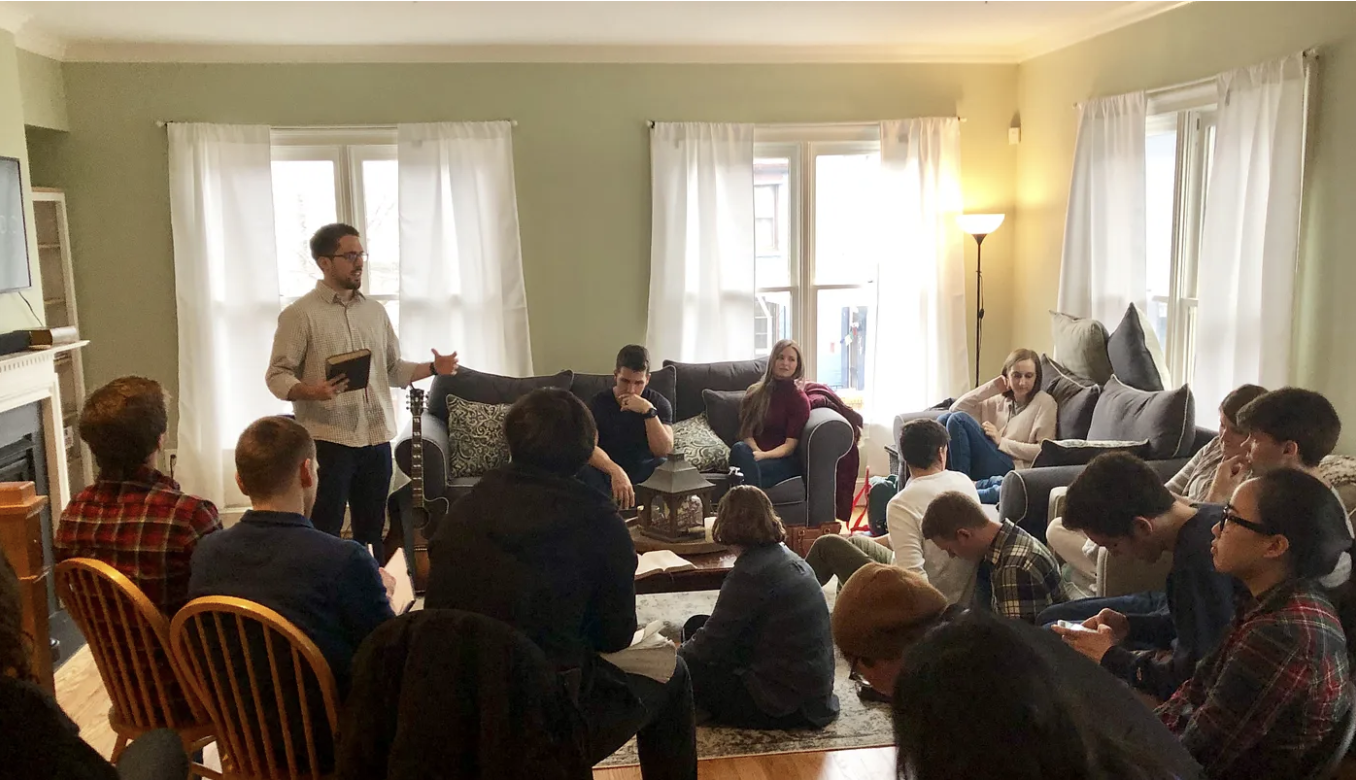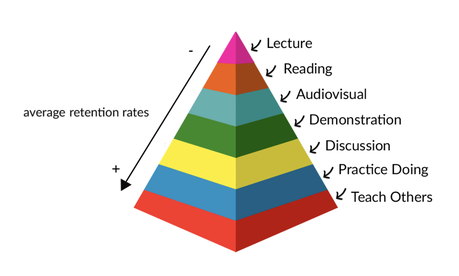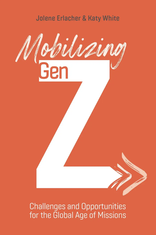|
Remember Covid? Pastors and churches across the country stepped into uncharted territory those first weeks of March and April in 2020. I prayed daily for my pastor friends and can only imagine the levels of stress that piled up around them as they led their respective churches through the Coronavirus crisis. With Sunday morning services needing to be cancelled, it left many scrambling to figure out how to do church. Because so much of what we do focuses on the Sunday morning service, this posed a very real challenge for church leadership. What do we do when our weekly hour and a half long service is no longer an option? That is the question everyone was wrestling with in those early months of the Covid crisis. I sometimes wonder now however if we missed an opportunity. It seems we've jumped back into business as usual and I'm wondering if there was another path to explore. I recently read an update from a Christian working in a Muslim majority country in Central Asia. They’d been working diligently alongside a local pastor to grow a small church made up of former Muslims. The group had found favor with a local property owner and had been meeting in a storefront building on Sundays for several years. Every Sunday the church of just over fifty gathered to worship together, to listen to the preaching of their very gifted pastor and to fellowship with one another. All that changed when the building owner began to come under increasing pressure from the local Muslim community. Even though he appreciated the monthly rent, he eventually decided it just wasn’t worth it and asked them to move out. What did they do when their weekly hour and a half long service was no longer an option? They didn’t have the option of streaming the pastor’s preaching and they knew they wouldn’t be able to find another building big enough for their needs. How could they go on? The pastor and elders met and realized that they were going to have to shift away from the larger group weekly gathering. They would need to meet in many smaller groups in peoples’ homes. Rather than centralized teaching, the teaching would need to be spread out among a number of young leaders. The pastor took the time he usually invested in preparing his sermon and instead began to invest that time in preparing men. While it has been a challenging time, it has also been a time of real growth. In the smaller group settings, people have found it easier to share, to interact and to practice the "one anothers" of scripture. Young leaders, given new responsibility and a lot more time with the pastor or an elder have matured quickly. One of the most exciting aspects of this shift to smaller groups meeting in homes rather than an official church building, is that members of the church have been more active in inviting their friends and neighbors to attend and non-believers have felt more comfortable to come and visit. More Muslims are both seeing and hearing the gospel than ever before and the church is growing - both spiritually and numerically. This church still finds a place to gather everyone together once each month for a larger gathering where they worship and celebrate and yes, listen to their pastor’s preaching. They are figuring things out as they have learned in a new, personal way the truth of Paul’s words in Romans 8:28, “And we know that all things work together for good to those who love God, to those who are called according to His purpose.” I hoped and prayed that the Coronavirus crisis would end quickly back in 2020. But I also prayed that God would shake up His church, refine us and teach us to walk in new, fresh (but very old) ways. I had hoped it would be an opportunity to learn from the church in Central Asia and China and Iran -- churches that cannot have large gatherings but rather come together in homes to “dedicate themselves to the apostles teaching and to fellowship, to the breaking of bread and to prayer.” Don't get me wrong - I love my local church family and our church and I don't think the legacy church is going anywhere or needs to. I just wonder if there are other ways to do church that more reflect Jesus' focus on disciple making rather than just a holy huddle. Are there hybrid models we can discover or create? Can we reimagine a church that is less about gathering and more about going? As I wrestle with scripture I suppose I'll always wrestle with these questions and my hope is that this article will help others begin to wrestle as well. Practical Handles Here are a few resources I’ve found helpful to begin to have a handle on how to help our congregations gather in smaller groups in homes.
The Coronavirus was challenging, there can be no doubt about that. It may be a challenge unlike any we've faced in our lifetimes though I suspect there will be more to come. It may not yet be the time to consider new ways of doing church in North America, but it seems there is an opportunity to discover new rhythms, new methods, new wine skins that may lead to greater levels of fellowship, faithfulness, disciple making, evangelism and maturity. And looking at the data coming out of the Barna Group and Pew Research, we could use greater levels of all of those. If you found this article helpful, pass it along to a friend who you think may benefit from reading it.
0 Comments
Last month I listened to an episode of the LEAD Pods Podcast about the growing challenges of raising up young leaders for our present and future churches. Among other things brought up in this insightful conversation was the reality that our church leadership is aging while there are fewer and fewer young leaders being raised up to replace those who retire. The average age of a pastor today is 60. It was 44 in 1992. Sam Rainer wrote about this last summer saying, “A typical pastor today is approaching retirement age. Frankly, there are not enough younger pastors to replace a large group of retiring Baby Boomer pastors. The perspective of some churches with older, retiring pastors is exacerbating the problem. Once they begin to search for a pastor, they will look for an idealized version of a 30-something Baby Boomer pastor from a bygone era. Obviously, this pastor does not exist. The few candidates available will look and lead very differently. As a result, churches will struggle to fill positions as willing candidates get frustrated with search teams.” Landon Coleman, in his article “Why are Pastors So Old Today” does a good job of highlighting six reasons for the void of upcoming pastors and a few thoughts about a way forward including the admonition that churches, “should not waste time blaming the younger generation, and they should not try to pin the blame on seminaries. Instead, churches should work to train up and raise up pastors from within their own ranks. Seminaries are a helpful part of preparation for pastoral ministry. Personally, I can’t imagine doing my job without seminary. However, in the plan and the providence of God, it is the local church’s job to raise up pastors – not academic institutions.” This brought me back to thinking about Gen Z. I wrote recently about mobilizing Gen Z for missions and I often hear folks (myself included) bemoaning this young generation and the ways they live and believe and think about life and faith. I don’t always understand them, however blaming them does not solve any of the challenges facing our missionary efforts or the future of the American church. It seems that the future of the church as we know it, led by highly educated, paid professionals, may soon be a thing of the past. Our seminaries are turning out fewer and fewer pastors and most going to college today are more focused on avoiding debt than stepping into a calling to serve the local church (or any of the humanities for that matter). The church of tomorrow will be led by Gen Z whether we like it or not and so we need to think more intentionally about how to raise them up, empower them and call them into service for the Lord. Jolene Erlacher, in a recent Leading Tomorrow podcast, highlighted the predominant learning styles of Gen Z. This got me thinking about how churches and mission agencies can be working to raise up tomorrow’s leaders and the new ways we must begin to think about this task. In the interview, Erlacher describes what she calls “EPIC” learning. EPIC stands for experiential, participatory, image rich, and connected. As I listened, it occurred to me that this type of learning is in line with what the pedagogical experts have always said about the best ways to learn, ways that our churches have almost always ignored. EPIC learning looks a lot like the old learning pyramid that has been around for the last few decades. Those over forty have known little else but lecture and reading as the ways we learn. While these may have worked for us, we need to rethink how we teach and make disciples of our younger counterparts. As a member of the Gen X cohort, I still love to learn in these ways, but it’s not about me. We need to explore this new way of teaching because it is the way Gen Z learns, because it’s actually more in line with the disciple making principles of Jesus, and because, if we don’t, we’ll probably begin to lose more and more of them as they find the church and mission agency irrelevant and more interested in protecting institutional traditions than in building the kingdom. It seems in many ways like the church in North America is approaching a hinge moment in history. Changes are coming. The church as we know it may be on its last leg. It may not look the same in the future. It may lose its institutional nature. It may no longer be able to support fully paid professionals. Two things are for certain however: The Church will continue to be the means through which Christ’s kingdom expands and it will be led by Gen Z. It was several years ago that I wrote about a ministry tool called the E-Scale. Used mostly in cross-cultural contexts, “The E-Scale helps compare the cultural distances that Christians need to move in order to communicate the gospel with others. E-0 refers to evangelism of church-going Christians. E-1 extends to the very same culture through one barrier, that of “church culture.” E-2 evangelism presses into a close, but still different, culture. E-3 evangelism pushes to very different cultures.”(1) The basic idea is that the closer a person is culturally to the people they are trying to reach, the fewer the barriers there are to overcome. Sharing with an old high school friend has few barriers for communication. Moving to a Central Asian village presents a profusion of barriers to overcome; language will need to be mastered, worldview will need to be understood, customs, history, and more will need to be learned and applied to the sharing of the gospel. The relative cultural distance in this setting is immense compared to talking with an old high school buddy. On the E-scale, a high school friend is E1 where new acquaintances in Central Asia are an E-3. Missiologists and missionaries alike have discovered the importance of partnering well with national churches and near culture churches in seeing the Gospel introduced into frontier mission fields. Investing deeply in the discipleship of believers who already know the language or who grew up in a culture that was more similar to the target people group than the western missionaries then becomes an important strategic work in frontier missions by reducing barriers to communication. Some have called this “near-culture missions” which The East West Center for Missions Research and Development defines as “reaching unreached people groups through sending missionaries from geographically, culturally, and linguistically proximate people groups. This has also been referred to as proximate missions.”(2) The more we can harness the innate skills and gifts of local believers to share the gospel the more often the gospel will be shared clearly and understandably. Near-culture missions is an important strategic opportunity that the global church has been embracing. Reading a new book, Mobilizing Gen Z: Challenges and Opportunities for the Global Age of Missions by Jolene Erlacher and Katy White, I’ve begun to re-evaluate what it means to be ‘near-culture.(3)” It started with a statement from a training document for Steiger International, a ministry focused on reaching urban youth around the world.(4) The current urban generation, connected by consumerism, social media and the entertainment industry, forms the largest global culture to ever exist. It spans the globe, sharing the same values, listening to the same music, watching the same movies and sharing the same posts. This global culture is largely influenced by one predominant worldview: Secular Humanism—God is irrelevant and man is at the center. In this relativistic culture, we are god and consumerism is our religion. Many have called Gen Z digital natives. Born between 1995 and 2010, the first of Gen Z were twelve years old when the iPhone was introduced in 2007. As a generation, most did not choose to have smartphones, their parents simply bought them for them. Embracing them fully however, they have come and are coming through their teenage years with 24/7 access to the internet and social media. While the mental health results of this has been nothing short of devastating,(5) it is clear that they are more connected globally than any previous generation. It has been said that a ten year old in Omaha could very well have as much in common with a ten year old in Rome or Rio or Riyadh than with their own grandparents. And so if it is true that Gen Z is the largest global culture to ever exist, then Erlacher and White are on to something important when they say, “Given the trends in shared perspectives and values of young people across cultures, Generation Z possesses a unique opportunity. An understanding of generational views in one cultural context may equip them to engage young people more effectively in other contexts.” Could Gen Z Christians be near-culture missionaries to Gen Z Muslims, Hindus, Buddhist and atheist Chinese around the world? I’m not sure they are waiting to find out. Last year I had a zoom call with a fifteen year old in Dallas who was leading discovery Bible studies with teens from different religious backgrounds from all across the globe on Discord, a social media platform used by the online gamer community. My daughter is connected with friends in France, Turkey and the UAE. No one mobilized them to go, they were already there. For all the challenges that Gen Z faces, I am excited to see where they will lead us in the work of completing the great commission. We certainly need to continue to focus on equipping near-culture Christians living inside the 10/40 window, but might it be that Gen Z believers who are already connected with Gen Z friends inside the unreached nations of the earth will be the next powerful force in kingdom expansion. Perhaps we need to focus less on getting them to go as we went, and rather on developing disciples who love God and love others and have a heart for making disciples wherever they are . . . because for many, they are already there. 1. Missionary statesman Ralph Winter and Bruce Koch wrote “Finishing the Task: The Unreached Peoples Challenge” in which they shared the idea of the E-Scale and how to apply it to missionary strategy. This was published in an eleven page article in the Winter 2002 issue of the International Journal of Frontier Missions.
2. THE BRIDGES OF GOD: Exploring the Strategic Significance of Near-Cultural Mission. This is an extensive article written by David Bogosian filled with clear definitions and examples from both the Bible and modern day missions efforts. Accessed Nov. 22, 2023 (http://ewcenter.org/?p=8786). 3. Erlacher, Jolene; White, Katy. Mobilizing Gen Z : Challenges and Opportunities for the Global Age of Missions. William Carey Publishing. Kindle Edition. 4. Steiger International website, “Is There More?,” downloadable PDF, 9. 5. It is beyond argument that giving pre-teens and teens smart phones and social media right as they are navigating what we all know as the most difficult time of our lives - junior high - has had devastating results on the mental health and overall quality of life for Gen Z. Jonathan Haidt writes about these issues at his Substack, After Babel. See also the Varkey Foundations global study of the general health and well being of Gen Z. Through over 20,000 surveys from 20 different countries there is a wealth of information in their report which you can read HERE. If you walk long enough in the various neighborhoods of the Christian faith, you will inevitably begin to notice the cul de sacs where groups gather around all sorts of factors: ethnic identity, doctrinal beliefs, native languages, experiential aspirations, worship style preferences - even favorite translations of the Bible. Finding our way into groups who are like us and with whom we feel we can walk out our understanding of Christian belief comfortably and faithfully is of course natural. In as much as we have all grown up being shaped by family and church life experiences, books we read and sermons we listen to it is a wonder we don’t have more groups dotting the landscape of Christianity. Like a cityscape filled with the architectural styles developed by generations of creative genius, the world of Christianity is a vivid expression of the beauty of the image bearing nature of human personality and perspective and cultural creativity. We are of course the body of Christ, individually and corporately. For just as we have many members in one body and all the members do not have the same function, so we, who are many, are one body in Christ, and individually members one of another (Romans 12:4-5). When lived in balance and with a proper perspective built on love and humility toward one another, Christianity is an amazing expression to a lost and broken world of the goodness, truth and beauty of God. Our witness is bold and our fellowship is a reflection of the love of 1 Corinthians 13. We are patient and kind and we don’t envy or boast. We aren’t proud. We don’t dishonor others and are not self-seeking or easily angered. We keep short accounts - no records of wrong. We never delight in evil and together rejoice in the truth. We always protect - even those we disagree with over doctrine or politics. We trust and hope and persevere, and we do all of this because love never fails. When we live Spirit filled and activated lives in the shadow of the 1 Corinthians 13 rubric of life, we become together what Corrie Ten Book called, “tramps for the Lord” who have left our hiding places to roam the Gap with the Savior. We are heaven’s expatriates, camping where the kingdom is best served. We are earth’s dispossessed, who’ve journeyed forth to give a dying world not only the Gospel but our own souls as well. We are members of God’s global dispersion down through history and out through the nations, reaching the unreached and blessing the families of earth.* Our differences then become the seasoning of our witness rather than the warts about which the world sees us fighting and arguing. We will still have robust discussions - arguments even - over points of interpretation, ideas about how to engage the world, what worship should look like and everything in between, but these discussions will be covered in love and cloaked in humility knowing that in this life, we see through a glass darkly. We will strive to walk in the paradox of grace and truth, knowing that grace without truth is not grace and truth without grace is not truth. And because we will fail often, we’ll be quick to ask forgiveness of our brother or sister. While all of this seems a tall order, it is the way forward for the North American church. We’ve been duped into kingless kingdoms of social justice, culture warring kingdoms of god and country or the bland sort of cultural Christianity which is little more than a safe civil religion. None of these hits the mark. Let us therefore work together in love to pursue our Lord into the harvest, shining our light in the darkness, being salt and yeast in a broken and distorted world, edifying and encouraging one another, dedicating our lives to studying the word of God, to prayer, to fellowship, to bold witness and above all, to love. A new commandment I give you: Love one another. As I have loved you, so you also must love one another. By this everyone will know that you are my disciples, if you love one another. Photo Credit * David Bryant defines world Christians with this description in his fantastic book, In The Gap: What it means to be a world Christian. Did Jesus give the Apostle Paul a strategy for reaching the nations? Yes, he did and it is a strategy for our day as well. Steve Addison often quips that we need to stop asking 'What would Jesus do?' and start asking another question: What did Jesus do? Luke 10:1-23 offers us a window into one of the things Jesus did and it is a window into both his methods of discipling his followers as well as a strategy he uses to reach into new areas with the gospel. It is a strategy that the Apostle Paul employs throughout his ministry and is especially visible on his second missionary journey as recorded in Acts chapters 16 - 18. This is of course not the only strategy that Jesus gives his followers nor is it the only strategy for reaching into new harvest fields that the Apostle Paul uses, but within Luke 10 are a number of examples and principles that we, like Paul, would do well to pay attention to and at the very least, try out. They are not the way we in the west usually go about things but they are the way that Jesus taught his first followers to take the gospel into new regions. Let's look at a few of the examples and principles from Luke 10. Pray for Harvesters In Luke 10:2 Jesus tells the 72 to pray for more workers. This is interesting because as sent ones, they are the workers. The implication seems to be that there are workers in the harvest! As Paul worked through Macedonia and Greece, the leaders of all of the churches that emerge in Acts 16 - 18 are new believers who came out of the harvest. Paul did not lead these churches. There is no mention of him even planting churches. Paul made disciples (Matthew 28:18-20) and churches emerged as new disciples were raised up and began to share the gospel and make disciples. Find the Person of Peace Jesus instructs the 72 to find a peaceful person, someone who welcomes them into their home. He gives them further instruction that, if a peaceful person cannot be found, they should brush the dust off of their feet and move on. It seems that there will be a God prepared person who welcomes them, or their won't be. The presence of that person or lack their of is out of their hands. It is a work of the Father who draws people to Jesus. Paul trusts Jesus' strategy. For Paul it looks like this: Enter a new town or context. Find the place where people gather - usually a synagogue. Preach the Gospel. Get kicked out. Discover that there are a handful of people who want to follow Jesus. When Paul proclaims the gospel there are always three responses as clearly articulated in Athens in Acts 17:32-33. When they heard about the resurrection of the dead, some of them sneered, but others said, “We want to hear you again on this subject.” At that, Paul left the Council. Some of the people became followers of Paul and believed. Paul knew that there would be three response:
Stay with the Person of Peace As part of Jesus' instructions, he also tells the 72 to not move around from house to house but rather to stay with the person of peace. Jesus does not tell us why we should stay, but in the example of Paul we see the fruit of staying in place. Paul is not the local who will establish the movement in each town. The local person - the cultural insider - will be the one to stay. Lydia, the Philippian Jailer, Jason in Thessalonica, the elders in Berea, Dionysius and Damaris in Athens, Aquilla and Priscilla in Corinth as well as Crispus the synagogue ruler and his entire household! These are the people who become the leaders of the gospel movements in each of their respective regions. Paul has stayed with them, he's shared meals with them and invested in raising them up to be disciples of Jesus! This is perhaps most clearly seen in Thessolonica where Paul spent just three Sabbaths [learn more]. Everywhere Paul goes he finds a person of peace, a God prepared person whom God is going to use to establish the local expression of faith. Paul has no plan to leave a “church planter” behind to lead the new church for a time. It seems that from the very beginning the plan is to have a new believer lead the church. These are just three of the principles from Luke 10 that Paul applies as he works to obey Jesus and make disciples. A deeper study of the sending out of the 12 in Luke 9, Matthew 10 and Mark 6 would be be helpful to further compare how Paul took the example of Jesus and applied it to his efforts to take the gospel to the very ends of the earth. If Jesus' example and the principles of Luke 10 were good enough for Paul, it seems we ought to at least look at these passages and explore what applying them to our current context might look like. Dear Dads, It seems crazy to think that just two weeks ago life was relatively normal. Now, it seems that everything has changed. There is a lot of uncertainty and if you’re like me, you’re still not entirely sure what is going on. There is a lot that we are all going through and a lot that we all need encouragement in right now, but with this letter I want to encourage you to do one thing: lead on Sunday morning in your home. Covid-19 is and will continue to be disruptive and hard. But in every difficulty there is opportunity. God meant it when he had Paul pen the words of Romans 8:28, “And we know that in all things God works for the good of those who love him, who have been called according to his purpose.” The reality of “church at home” is probably going to be a reality for the foreseeable future. Our church leaders and pastors are doing a great job creating online content that can help us through this time. And while it's good to sit down in front of the TV or computer screen and watch and listen as a family, there is an amazing opportunity to step up and lead your family in being the church, in actively doing church at home. Jesus told us that “where two or three gather in my name, there am I with them.” Gather your family in the name of Jesus. Lead them in prayer and worship and in fellowship. This is an opportunity to teach your children to seek the face of Jesus, to model for them prayer and worship and what it looks like to be a man of God who looks to actively apply the teachings of Jesus. Help them learn to actively apply the teaching of Jesus in their lives. There is a simple format that can be followed that will help you lead your family. Divide your Sunday morning as a family into three thirds. Looking Back CARE: The first third of your time can be focused on caring for one another and worship. Start by praying for your time together and then ask two simple questions and allow everyone to share about how their week went.
After everyone has shared, invite your wife and kids to join you in praising God for the things that are going well and to pray for one another about the needs that were expressed. WORSHIP: Lead your family into a time of worship. Some of us are musically gifted, but for the rest of us this may mean asking your kids what their favorite worship songs are and finding them on Youtube to listen to or sing along with. It may be an opportunity to read some of the Psalms together. Regardless of what this looks like at your home, have fun worshiping the Lord together. If you have young kids, let them beat spoons on a pan or dance as they worship. CAST VISION: Is there a verse that has been particularly meaningful to you this week? Is there an area you are hoping you and your family can grow in? Take a moment to cast some vision for the things that God is putting on your heart for your family. Share a verse from the Bible to encourage your family in the way you know they need to be encouraged. Looking Up The second third of your time together can be spent looking into the word of God together. Acts 2:42 paints a picture of the early church saying "that they devoted themselves to the apostles’ teaching and to fellowship, to the breaking of bread and to prayer." This is the time to learn from the word of God. This would be a great time to tune into your church’s online service to listen together to your pastor’s message for the week. You could also use the SWORD method to lead your family in discovery Bible study, helping teach your kids how to dig into God’s word for themselves. Together you will learn what Jesus has for each of you in a particular passage of scripture. [learn about discovery Bible study] Regardless, this second third is a time to dedicate to studying the Bible. Looking Ahead The final third of your time together should be spent looking ahead to the week to come. It is a time to plan together how you can apply what you’ve learned and be a blessing to others in the coming week. A few simple questions for this time are:
After you have discussed these as a family, ask your kids to hold you accountable to actually do the things you’ve said you would do. End your time together by praying for your family. Then enjoy a great meal together! Covid-19 is going to be a life changing event for all of us. But as fathers we have an opportunity to step in and lead our families into a deeper place of faith and following. Imagine if our kids look back at this time and remember most of all that their dad led them closer to Jesus! May it be! |
The E2E Community
Categories
All
Good Books
Archives
April 2024
|
Proudly powered by Weebly













